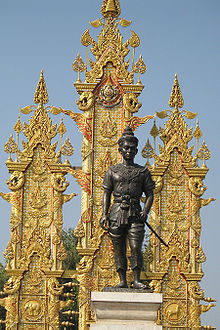- Mangrai the Great
-
King Mangrai (1238-1317) was the 25th King of Ngoen Yang (r.1261-1296) and the first King of Chiang Mai (r.1296-1317), capital of the Lanna Kingdom (1296-1558).[1]
Contents
Early years
King Mangrai was born on October 2, 1238 in Ngoen Yang,[1] (present day Chiang Saen), in Thailand on the Mekong River which forms the border with Yunnan in China) as the son of the local ruler Lao Meng and his wife Ua Ming Chommueang, a princess from the Tai Lue city of Chiang Rung, in Sipsongpanna (Xishuangbanna) in Yunnan.
In 1259 Mangrai succeeded his father to become the first independent king of the unified Tai city states in northern Lanna and what is now northern Laos. Seeing that all the Tai states were disuntied and in danger, Mangrai quickly expanded his kingdom by conquering Muang Lai, Chiang Kham and Chiang Khong and intiating alliances with other states.
In 1262 he founded the city of Chiang Rai as his new capital in the Kok River basin. He seems also to have been operating around this time in the area of Fang still in the Upper Kok Valley.[1]
In 1280 Mangrai first made peace between King Ngam Mueang of Phayao and King Ram Khamhaeng of Sukhothai, who had seduced the former's queen; and then was able to make a pact between the three Kings to defend their lands against the expanding Mongol Empire.
While still living in the area of Fang he was visited by some merchants from the Mon kingdom of Haripunchai (Haripunjaya, now known as Lamphun), and hearing of the wealth of that kingdom he determined to conquer it, even against the advice of his councillors.[1]
As it was deemed impossible to take the city by force, he sent a skilful merchant called Ai Fa to gain the confidence of the King Yi Ba, and in time he became the Chief Minister and managed to undermine the King's authority.
In 1281, with the people in a state of discontent, Mangrai defeated the Mon kingdom, and added the city and its wealth to his kingdom, while Yi ba, the last king of Hariphunchai, was forced to flee south to Lampang.
Chiang Mai Era
In 1292 Mangrai choose a new site for his capital, but construction only began in 1296, when he founded Chiang Mai (New City) on the western bank of the Ping River, which has been the capital of the northern provinces more or less ever since.[1]
A few years later, Yi Ba's son, King Boek of Lampang, attacked Chiang Mai with a large army. However, King Mangrai and his second son, Prince Khram, fought back against the Lampang army.
In a personal combat on elephant back between Prince Khram and King Boek at Khua Mung, a village near Lamphun. King Boek lost and ordered the withdrawal of his remaining men. As King Boek fled by way of the Doi Khun Tan mountain range between Lamphun and Lampang, he was caught and executed.[1] When King Mangrai's troops occupied the city of Lampang, King Yi Ba was made to flee again, this time to Phitsanulok.
Death and succession
King Mangrai's eldest son tried to seize the throne but was caught and executed, and his second son Khun Kham was set up to succeed him.[1] King Mangrai died in 1317 at Chiang Mai; reputedly during a thunderstorm he was hit by lightning in the city's market.
There followed a period of confusion in the succession, with six kings ruling in eleven years, which could have been disastrous if the northern powers had not fallen upon their own troubles, and Sukhothai to the south had not also been weakened.
It was not until the ascension of the king's grandson Kham Fu in 1328 that the kingdom once again achieved the stability it had gained during the reign of its founder.[1]
References
Categories:- 1239 births
- 1317 deaths
- Thai monarchs
- Tai history
- Deaths by lightning
- Thai people stubs
Wikimedia Foundation. 2010.

